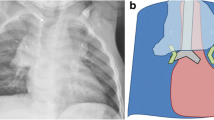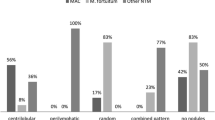Abstract
Introduction
The significance of mediastinal lymphadenopathy in bacterial pneumonia is unclear.
Methods
We performed a retrospective analysis of mediastinal lymph node size determined by chest CT in patients with bacteremic pneumococcal pneumonia. All patients who had positive blood cultures for streptococcus pneumonia over an 11-year period and had a chest CT scan (index CT) within 2 weeks of the positive blood culture were included in the study. Two thoracic radiologists and one pulmonologist independently examined the index CT plus any chest CT scans performed prior (pre-CT) or after (post-CT) the bacteremic episode.
Results
The study cohort of 49 patients was 57% male, 65% White, with mean age of 53 (SD = 20) years. Mediastinal lymphadenopathy was detected in 25/49 (51%) of the cases. The mean size of the largest mediastinal lymph node in short axis was 0.99 (SD = 0.71), ranging from 0.0 to 2.05 cm. There was no correlation noted between the number of lobes involved with pneumonia, and the size of the largest mediastinal lymph node (p = 0.33) or the number of pathologically enlarged mediastinal lymph nodes (p = 0.08). There was a statistically significant increase in the mean size of the largest lymph node between the pre-CT and index-CT group (p = 0.02), and decrease between the index-CT group and the post-CT (p = 0.03).
Conclusion
Pneumococcal pneumonia with bacteremia is associated with mild mediastinal lymph node enlargement. The presence of marked mediastinal lymphadenopathy (short axis LN size > 2 cm) should not be assumed from pneumococcal pneumonia.




Similar content being viewed by others
References
Silvestri GA, Gonzalez AV, Jantz MA, Margolis ML, Gould MK, Tanoue LT, Harris LJ, Detterbeck FC (2013) Methods for staging non-small cell lung cancer: diagnosis and management of lung cancer, 3rd ed: American College of Chest Physicians evidence-based clinical practice guidelines. Chest 143:e211S–e250S
Manucha V, Kaur G, Verma K (2013) Endoscopic ultrasound-guided fine needle aspiration (EUS-FNA) of mediastinal lymph nodes: experience from region with high prevalence of tuberculosis. Diagn Cytopathol 41:1019–1022
Stigt JA, Boers JE, Oostdijk AH, van den Berg JW, Groen HJ (2011) Mediastinal incidentalomas. J Thorac Oncol 6:1345–1349
Souza CA, Muller NL, Lee KS, Johkoh T, Mitsuhiro H, Chong S (2006) Idiopathic interstitial pneumonias: prevalence of mediastinal lymph node enlargement in 206 patients. AJR Am J Roentgenol 186:995–999
Pastis NJ Jr, Van Bakel AB, Brand TM, Ravenel JG, Gilbert GE, Silvestri GA, Judson MA (2011) Mediastinal lymphadenopathy in patients undergoing cardiac transplant evaluation. Chest 139:1451–1457
Hassan T, McLaughlin AM, O’Connell F, Gibbons N, Nicholson S, Keane J (2011) EBUS-TBNA performs well in the diagnosis of isolated thoracic tuberculous lymphadenopathy. Am J Respir Crit Care Med 183:136–137
Heddurshetti R, Pumpradit W, Lutwick LI (2001) Pulmonary manifestations of bioterrorism. Curr Infect Dis Rep 3:249–257
Tarnvik A, Berglund L (2003) Tularaemia. Eur Respir J 21:361–373
Muller NL, Webb WR, Gamsu G (1985) Subcarinal lymph node enlargement: radiographic findings and CT correlation. AJR Am J Roentgenol 145:15–19
Schmidt AF Jr, Rodrigues OR, Matheus RS, Kim Jdu U, Jatene FB (2007) Mediastinal lymph node distribution, size and number: definitions based on an anatomical study. J Bras Pneumol 33:134–140
Stein DL, Haramati LB, Spindola-Franco H, Friedman J, Klapper PJ (2005) Intrathoracic lymphadenopathy in hospitalized patients with pneumococcal pneumonia. Chest 127:1271–1275
Woodhead M (2002) Community-acquired pneumonia in Europe: causative pathogens and resistance patterns. Eur Respir J Suppl 36:20s–27s
Ruiz M, Ewig S, Marcos MA, Martinez JA, Arancibia F, Mensa J, Torres A (1999) Etiology of community-acquired pneumonia: impact of age, comorbidity, and severity. Am J Respir Crit Care Med 160:397–405
Torres A (1999) Re-evaluation of the etiology of community-acquired pneumonia: the impact of the age of comorbidity and of the severity of the pneumonia and of other additional factors. Arch Bronconeumol 35(Suppl 3):62–64
Craven DE, Steger KA (1995) Epidemiology of nosocomial pneumonia. New perspectives on an old disease. Chest 108:1S–16S
Macfarlane JT, Miller AC, Roderick Smith WH, Morris AH, Rose DH (1984) Comparative radiographic features of community acquired Legionnaires’ disease, pneumococcal pneumonia, mycoplasma pneumonia, and psittacosis. Thorax 39:28–33
Okada F, Ando Y, Matsushita S, Ishii R, Nakayama T, Morikawa K, Ono A, Maeda T, Mori H (2012) Thin-section CT findings of patients with acute Streptococcus pneumoniae pneumonia with and without concurrent infection. Br J Radiol 85:e357–e364
Nambu A, Saito A, Araki T, Ozawa K, Hiejima Y, Akao M, Ohki Z, Yamaguchi H (2006) Chlamydia pneumoniae: comparison with findings of Mycoplasma pneumoniae and Streptococcus pneumoniae at thin-section CT. Radiology 238:330–338
Author information
Authors and Affiliations
Contributions
MAJ is the guarantor of the paper, and takes responsibility for the integrity of the work as a whole, from inception to published article. All authors were involved in the study design. SC, AM, HC, NR, performed the data collection and data entry. Two radiologists, JF and FJH, interpreted the CT scan reports. RY performed the statistical analysis. All authors contributed to the writing of the manuscript.
Corresponding author
Ethics declarations
Conflicts of interest
MAJ consultant for Janssen, Celgene, Questcor, Mistubishi-Tanabe, Novartis. AC, SC, AM, HC, NR, JH, FJH declare that they have no conflict of interest.
Ethical Approval
All procedures performed in studies involving human participants were in accordance with the ethical standards of the institutional research committee. The Institutional Review Board of Albany Medical College approved this study
Rights and permissions
About this article
Cite this article
Chopra, A., Modi, A., Chaudhry, H. et al. Assessment of Mediastinal Lymph Node Size in Pneumococcal Pneumonia with Bacteremia. Lung 196, 43–48 (2018). https://doi.org/10.1007/s00408-017-0071-9
Received:
Accepted:
Published:
Issue Date:
DOI: https://doi.org/10.1007/s00408-017-0071-9




